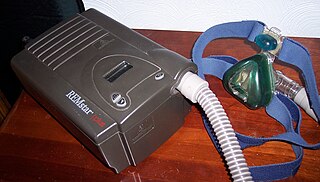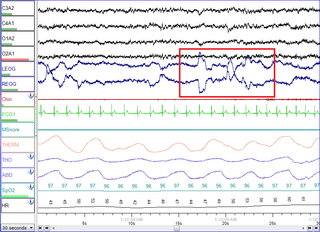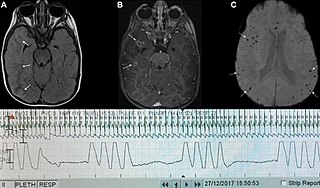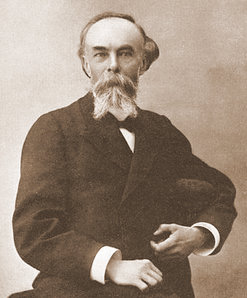
Sleep apnea is a sleep-related breathing disorder in which repetitive pauses in breathing, periods of shallow breathing, or collapse of the upper airway during sleep results in poor ventilation and sleep disruption. Each pause in breathing can last for a few seconds to a few minutes and occurs many times a night. A choking or snorting sound may occur as breathing resumes. Common symptoms include daytime sleepiness, snoring, and non restorative sleep despite adequate sleep time. Because the disorder disrupts normal sleep, those affected may experience sleepiness or feel tired during the day. It is often a chronic condition.
Respiration may refer to:
Apnea, BrE: apnoea, is the temporary cessation of breathing. During apnea, there is no movement of the muscles of inhalation, and the volume of the lungs initially remains unchanged. Depending on how blocked the airways are, there may or may not be a flow of gas between the lungs and the environment. If there is sufficient flow, gas exchange within the lungs and cellular respiration would not be severely affected. Voluntarily doing this is called holding one's breath. Apnea may first be diagnosed in childhood, and it is recommended to consult an ENT specialist, allergist or sleep physician to discuss symptoms when noticed; malformation and/or malfunctioning of the upper airways may be observed by an orthodontist.

Obesity hypoventilation syndrome (OHS) is a condition in which severely overweight people fail to breathe rapidly or deeply enough, resulting in low oxygen levels and high blood carbon dioxide (CO2) levels. The syndrome is often associated with obstructive sleep apnea (OSA), which causes periods of absent or reduced breathing in sleep, resulting in many partial awakenings during the night and sleepiness during the day. The disease puts strain on the heart, which may lead to heart failure and leg swelling.
In physiology, respiration is the movement of oxygen from the outside environment to the cells within tissues, and the removal of carbon dioxide in the opposite direction to the surrounding environment.

Cheyne–Stokes respiration is an abnormal pattern of breathing characterized by progressively deeper, and sometimes faster, breathing followed by a gradual decrease that results in a temporary stop in breathing called an apnea. The pattern repeats, with each cycle usually taking 30 seconds to 2 minutes. It is an oscillation of ventilation between apnea and hyperpnea with a crescendo-diminuendo pattern, and is associated with changing serum partial pressures of oxygen and carbon dioxide.

Kussmaul breathing is a deep and labored breathing pattern often associated with severe metabolic acidosis, particularly diabetic ketoacidosis (DKA) but also kidney failure. It is a form of hyperventilation, which is any breathing pattern that reduces carbon dioxide in the blood due to increased rate or depth of respiration.

Polysomnography (PSG), a type of sleep study, is a multi-parameter study of sleep and a diagnostic tool in sleep medicine. The test result is called a polysomnogram, also abbreviated PSG. The name is derived from Greek and Latin roots: the Greek πολύς, the Latin somnus ("sleep"), and the Greek γράφειν.

Biot's breathing or ataxic breathing, is an abnormal pattern of breathing characterized by variable tidal volume, random apneas, and no regularity. It is named for Camille Biot, who characterized it in 1876.

Obstructive sleep apnea (OSA) is the most common sleep-related breathing disorder and is characterized by recurrent episodes of complete or partial obstruction of the upper airway leading to reduced or absent breathing during sleep. These episodes are termed "apneas" with complete or near-complete cessation of breathing, or "hypopneas" when the reduction in breathing is partial. In either case, a fall in blood oxygen saturation, a disruption in sleep, or both, may result. A high frequency of apneas or hypopneas during sleep may interfere with the quality of sleep, which – in combination with disturbances in blood oxygenation – is thought to contribute to negative consequences to health and quality of life. The terms obstructive sleep apnea syndrome (OSAS) or obstructive sleep apnea–hypopnea syndrome (OSAHS) may be used to refer to OSA when it is associated with symptoms during the daytime.
Agonal respiration, gasping respiration or agonal breathing is a distinct abnormal pattern of breathing and brainstem reflex characterized by gasping, labored breathing, accompanied by strange vocalizations and myoclonus. Possible causes include cerebral ischemia, extreme hypoxia, or even anoxia. Agonal breathing is an extremely serious medical sign requiring immediate medical attention, as the condition generally progresses to complete apnea and heralds death. The duration of agonal respiration can be as brief as two breaths or last up to several hours.
The respiratory rate is the rate at which breathing occurs; it is set and controlled by the respiratory center of the brain. A person's respiratory rate is usually measured in breaths per minute.
Biot or BIOT may refer to:
When we sleep, our breathing changes due to normal biological processes that affect both our respiratory and muscular systems.
Juxtacapillary receptors, J-receptors, or pulmonary C-fiber receptors are sensory nerve endings located within the alveolar walls in juxtaposition to the pulmonary capillaries of the lung, and are innervated by fibers of the vagus nerve. Although their functional role is unclear, J-receptors respond to events such as pulmonary edema, pulmonary emboli, pneumonia, congestive heart failure and barotrauma, which cause a decrease in oxygenation and thus lead to an increase in respiration. They may be also stimulated by hyperinflation of the lung as well as intravenous or intracardiac administration of chemicals such as capsaicin. The stimulation of the J-receptors causes a reflex increase in breathing rate, and is also thought to be involved in the sensation of dyspnea, the subjective sensation of difficulty breathing. The reflex response that is produced is apnea followed by rapid breathing, bradycardia, and hypotension. The physiologic role of this reflex is uncertain, but it probably occurs in pathologic states such as pulmonary congestion or embolization. These receptors were discovered by Autar Paintal.

Breathing is the process of moving air into and from the lungs to facilitate gas exchange with the internal environment, mostly to flush out carbon dioxide and bring in oxygen.

Camille Biot was a French physician who is remembered for describing Biot's respiration.
Central sleep apnea (CSA) or central sleep apnea syndrome (CSAS) is a sleep-related disorder in which the effort to breathe is diminished or absent, typically for 10 to 30 seconds either intermittently or in cycles, and is usually associated with a reduction in blood oxygen saturation. CSA is usually due to an instability in the body's feedback mechanisms that control respiration. Central sleep apnea can also be an indicator of Arnold–Chiari malformation.
Periodic breathing is clusters of breaths separated by intervals of apnea or near-apnea. As opposed to normal breathing which is usually regular, periodic breathing is defined as three or more episodes of central apnea lasting at least 4 seconds, separated by no more than 30 seconds of normal breathing.
RPM-30-2-Can Do is a mnemonic device for the criteria used in the START triage system, which is used to sort patients into categories at a mass casualty incident. The mnemonic is pronounced "R, P, M, thirty, two, can do."






